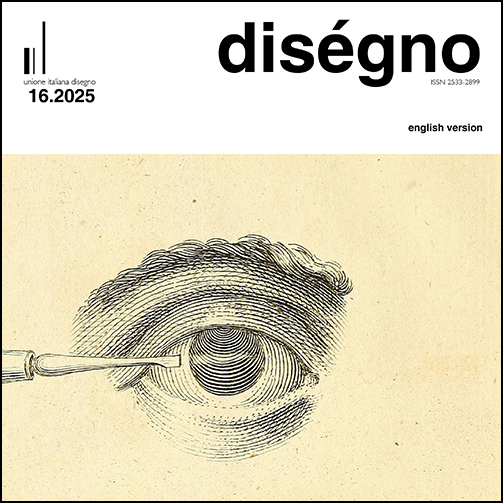Is Architectural Drawing a Language? Symbols, Signs, Pictograms, Ideograms and Drawings
DOI:
https://doi.org/10.26375/disegno.16.2025.8Keywords:
architectural drawing, language, symbolic systems, graphic thinking, Nelson GoodmanAbstract
Articulate language was established in the 20th century as the superior model of thought. It claimed a monopoly on the model of rational thought, even advocating a homomorphism between language and brain structure. We defend here the autonomy of architectural drawing over any linguistic discipline with the arguments that will be developed in six fields of debate. This analysis will argue why, stricto sensu, architectural drawing should not be considered a language. In our view, drawings do not ‘mean’ anything; rather, they either represent or shape the world. The lack of correlation between a syntactic and semantic field denies one of the basic principles of language. Drawing, especially architectural drawing, is based on the mathematical analysis process of Euclid’s geometry and does not require deductive reasoning based on logical or natural language. Neither does conceptual art based on language models seem to have produced remarkable works of art, nor has the attack on the visual brought even some of what was promised.
Goodman’s symbol system models have provided a more useful way to understand the specifics of architectural drawing as part of a representational symbolic system, beyond ‘languages and notations’. Finally, neuroscience posits the coexistence, without privilege, of a visual cognitive style as distinct from verbal cognitive style.
References
Alberti, L.B. (1991). De Re Aedificatoria. Madrid: Ediciones Akal, S.A. [Primera ed. De Re Aedificatoria. 1452].
Barthes, R. (1986). Lo obvio y lo obtuso, Imágenes, gestos, voces. Barcelona: Ediciones Paidós. [Primera ed. L’obvie es l’obtus. Essais critiques. Paris: Seuil 1982].
Bergen, B. K. (2012). Louder than Words. The New Science of How the Mind Makes Meaning. New York: Basic Books.
Berkeley, G. (1992). Tratado sobre los principios del conocimiento humano, vol. I. Madrid: Alianza Editorial, S.A. [Primera ed. A Treatise Concerning the Principles of Human Knowledge. Aaron Rhames 1710].
Bourriaud, N. (2009). Formas de vida. El arte moderno y la invención de sí. Murcia: CENDEAC. [Primera ed. Formes de vie: l’art moderne et l’invention de soi. Denoel 1999].
Cabezas, L., Copón, M., Fuentes, J. M., López Vílchez, I., Oliver, J. C., Ureña, C. (2011). Dibujo y construcción de la realidad. Madrid: Cátedra.
Carpo M. (2011). The Alphabet and the Algorithm. Cambridge, Massachusetts: The MIT Press.
Cassirer, E. (1968). Antropología filosófica. Introducción a una filosofía de la cultura. Ciudad de México: Fondo de Cultura Económica. [Primera ed. An Essay on Man: An Introduction to a Philosophy of Human Culture. Yale & New Haven 1944].
Castiglione, B. (1978). Lettera a Leone X. En A. Bruschi, C. Maltese, M. Tafuri, R. Bonelli. (Eds.). Scritti rinascimentali di architettura, pp. 459-484. Milano: Il Polifilo.
Cesariano, C. (1521). Di Lucio Vitruuio Pollione de architectura libri dece. Como.
Croce, B. (2014). Estetica come scienza dell’espressione e linguistica generale. Napoli: Bibliopolis.
Euclides. (1991). Elementos. Libros I-IV. Madrid: Gredos. [Primera ed. Elementos. Libros I-IV. 300 a.C.].
Evans, R. (1997). Translations from Drawing to Building. Cambridge, Massachusetts, EE.UU: The MIT press. [Primera ed. Translations from Drawing to Building. 1995].
Gándara, L. (2014). La escritura china: tan lejos y tan cerca. En Revista Dang Dai, No. 9, Buenos Aires.
Gandelsonas, M. (1998). Linguistics in Architecture. En M. Hays (Ed.). Architecture Theory since 1968,pp. 112-123. Cambridge: The MIT press.
Gardner, H. (2011). Frames of Mind: The Theory of Multiple Intelligences. New York: Basic Books. [Primera ed. Frames of Mind: The Theory of Multiple Intelligences. New York: Basic Books 1983].
Goodman, N. (1976). Languages of Art. An approach to a theory of symbols. Indianapolis: Hackett Pub. Cob.
Hew, S. (2012). Using Combining Evolution of Pictogram Chinese Characters to Represent Ideogrammic Compounds Chinese Characters. En K. Kwack (Ed.). 7th International Conference on Computing and Convergence Technology (ICCCT) Proceedings, pp. 219-223. Seoul, South Korea, 3-5 diciembre 2012, Seoul: IEEE.
Jay, M. (2003). Devolver la mirada. La respuesta americanan a la crítica francesa al ocularcentrísmo. En Estudios Visuales, vol I, pp. 61-82. Madrid: Cendeac.
Jiménez, J. (1986). Imagenes del hombre. Fundamentos de estética. Madrid: Tecnos S.A.
Jiménez, J. (2013, gennaio 30). ¿Qué es una imagen? [Video]. YouTube. <https://www.youtube.com/watch?v=Mhy40SRQuQg> (accessed 28 May 2025).
Koriat, A., Levy, I. (1979). Figural symbolism in Chinese ideographs. En Journal of Psycholinguistic Research, vol. VIII (4), pp. 353-365. <https://doi.org/10.1007/BF01067139> (accessed 29 May 2025).
Maldonado, T. (2004). ¿Es la arquitectura un texto? Y otros escritos. Buenos Aíres: Infinito.
Sainz Avia, J. (1990). El dibujo de arquitectura.Teoría e historia de un lenguaje gráfico. Madrid: Editorial Nerea,S.A.
Scruton, R. (1979). The Aesthetics of Architecture. London: Methuen & Co.
Scruton, R. (2017). La belleza. Barcelona: Editorial Elba S.L.
Stangos, N. (1986). Conceptos de arte moderno. Madrid: Alianza editorial.
Summerson, J. (1963). The Classical Language of Architecture. London: Thames & Hudson Ltd.
Torri, G.(2012). Hiding Words behind the Signs: The Use of Logograms in Hittite Seribal Praxis. En Orientalia, vol. 81(2), pp. 124-132.
Venturi, R. (1982). Complejidad y contradicción en la arquitectura. Barcelona: Gustavo Gili. [Primera ed. Complexity and Contradiction in Architecture. New York: Doubleday & Company 1966].
Wilczek, F. (2016). El mundo como obra de arte. En busca del diseño profundo de la naturaleza. Barcelona: Crítica. [Primera ed. The Lightness of Being: Mass, Ether, and the Unification of Forces. New York: Basic Books 2008].
Downloads
Published
How to Cite
Issue
Section
License
Copyright (c) 2025 diségno

This work is licensed under a Creative Commons Attribution 4.0 International License.






